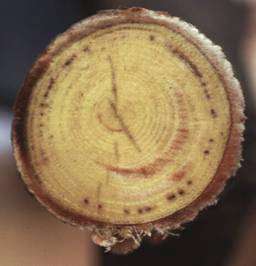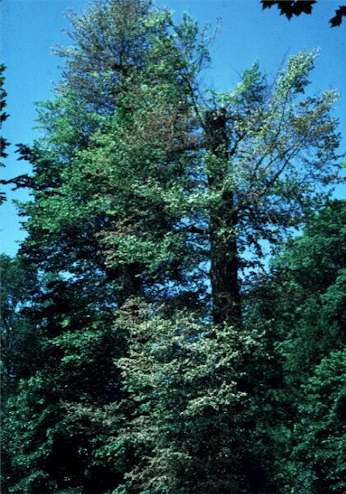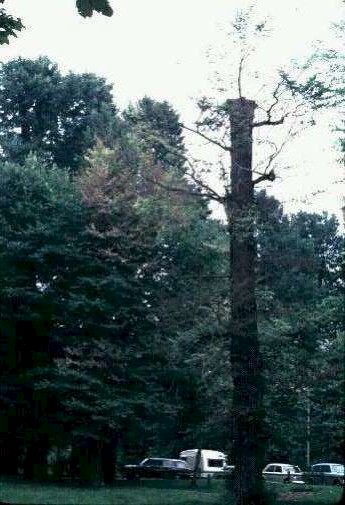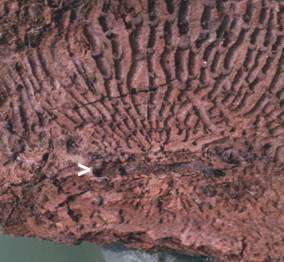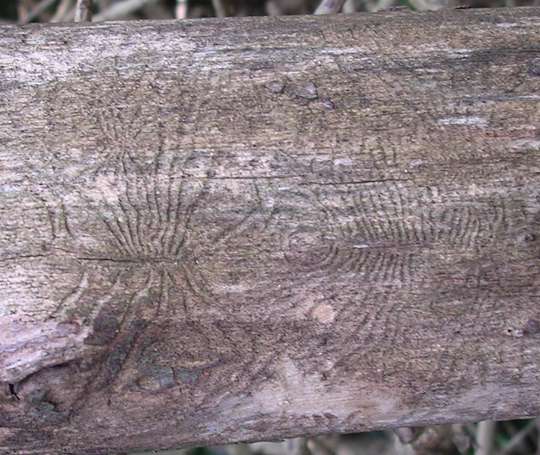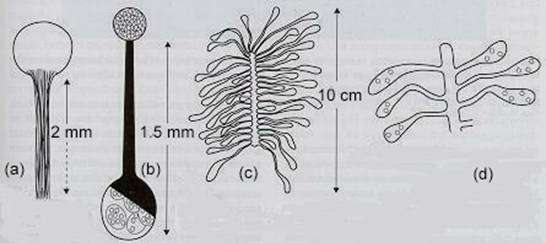..
FOCUS TOPIC: DUTCH ELM DISEASE Historical overview Several species of elm (Ulmus spp.) occur naturally across much of the Northern Hemisphere and live in balance with the local population of potential pathogens, such as Ophiostoma ulmi and O. novo-ulmi (Ascomycota) - the two organisms that cause Dutch elm disease. But this balance can be disrupted when trees (or logs carrying the elm disease fungus) are transported between continents, introducing new strains to which the local elm population has never been exposed. This has happened repeatedly over the past century and has caused massive damage to elm populations in Europe and North America.. Dutch elm disease (DED) is so-named because it was first identified by scientists in the Netherlands, but it is thought to have its origins in Asia, where elms show some natural degree of resistance to infection. The disease was first recorded in Britain in 1927, resulting in the death of about 10% of the elm population. Soon afterwards, the disease was transported to North America, probably on shipments of elm logs that were imported for cabinet-making. From the 1930s onwards, the disease caused major epidemics across much of North America, destroying some 40 million elms. More recently, in the 1960s and 70s, new major epidemics of Dutch elm disease began to appear around the English ports and spread rapidly across much of Britain, destroying huge numbers of trees. These new outbreaks were caused by a more aggressive strain of the pathogen which has subsequently spread across much of Europe, decimating the elm population and transforming the landscape completely. There is little doubt that the new aggressive strains were introduced on shipments of elm logs that had not been de-barked before shipment - a quarantine requirement that, if adhered to rigorously, could have prevented the more aggressive strains from entering Britain in recent times. The disease cycle Ophiostoma ulmi and O. novo-ulmi are the two species that cause Dutch elm disease, and they are notable because they are vectored by bark beetles-boring beetles, especially Scolytus multistriatus or Hylurgopinus rufipes. The disease cycle begins when beetles that have over-wintered in the bark of recently killed trees emerge in Spring and fly to neighbouring healthy trees, where they feed on the bark of the young twigs. During feeding, the beetles cause incidental damage to the xylem (the water-conducting vessels) and thereby introduce the fungus into the tree. The fungus then spreads in the xylem, by growing in a yeast-like budding phase and causing blockage of the xylem vessels Fig. 1). This soon results in death of the whole tree or some of its major branches (Figs 2,3). Once the tree or its major branches have died, the bark becomes suitable for egg-laying. Female bark beetles bore into the bark and eat out a channel in the inner bark, depositing eggs along its length - the ‘brood gallery’ (Fig. 4). The eggs then hatch and the young larvae eat out a series of radiating channels before they pupate for over-wintering. Meanwhile, the fungus that killed the tree grows from the xylem into the bark and sporulates in the beetle tunnels. In this way, the young adult beetles that emerge from the pupae in the following spring become contaminated with spores; they leave the bark and fly in search of new trees, repeating the disease cycle.
Fig 1. Section of a branch from a dying elm tree, showing a ring of blocked, discoloured xylem vessels from a non-lethal attack in a previous growing season. [© Jim Deacon]
Fig 2: Sequence (from left to right) of thinning of the crowns of an avenue of elm trees, caused by Dutch elm disease over a 2-3 month period in Cambridge, 1970. Initially (far left) the only evidence of disease was a slight thinning and death of the terminal branches. But as the season progressed the trees died rapidly (centre and right), and the bark became suitable for egg-laying by bark beetles. These trees were part of a long avenue of elms. Within 2 years the whole avenue was dead and the trees were extracted. [© Jim Deacon] [Note: The truncated tops of these trees are the result of controlled pruning, because elms have a strong tendency to shed major branches, posing a danger to people. The poet and story-teller, Rudyard Kipling wrote a rhyme on this, in a poem called "A Tree Song": Ellum she hateth mankind, and waiteth / Till every gust be laid / To drop a limb on the head of him / That anyway trusts her shade. / But whether a lad be sober or sad, / Or mellow with ale from the horn, / He will take no wrong when he lieth along / 'Neath Oak, and Ash, and Thorn!
Fig 4. Beetle brood gallery in the inner bark of a dead elm tree. The initial gallery caused by the adult female is marked by an arrowhead. Radiating from this are galleries produced by the young larvae that feed on the inner bark and will eventually emerge as young adults the following spring. If the newly emerging generation of beetles are carrying spores of Ophiostoma they can transmit the disease to healthy trees. [© Jim Deacon]
Fig 5. A dead branch of an elm tree with the brood galleries of Scolytus beetles. The bark had long disappeared from this tree but damage to the cambium caused by bark beetles is still clear. [© Jim Deacon] The fungus-vector relationship clearly benefits both partners, because the beetle carries the fungus to a new host, while the beetle is ensured of a fresh supply of breeding sites in the bark of newly killed trees - it will not lay eggs in older, dead bark. As shown in Fig. 5, Ophiostoma produces two types of stalked sporing structure within the beetle galleries - a coremium consisting of an aggregated mass of hyphae with a sticky head comprising many millions of asexual spores (conidia), and a sexual stage termed a cleistothecium with a long neck which extrudes ascospores in a mucilaginous matrix. These sticky spores contaminate the beetles that emerge in spring, and can infect new branches when the beetle flies to nearby healthy trees. The sexual stage also can ensure the generation of recombinant strains, and again the beetle is involved in this because adult beetles feed on the bark late in the season, introducing new strains of the pathogen, often different from the strain that killed the tree. In addition to its spread by beetle vectors, Dutch elm disease perhaps also spreads from tree to tree by root grafts, especially along avenues of closely planted elms.
Fig 6. Dutch elm disease. (a) Diagram of an intact coremium. (b) Sexual stage of Ophiostoma – a long-necked cleistothecium (closed fruitbody) containing oval asci each containing 8 ascospores. The asci break down at maturity and the ascospores are extruded in mulicage at the tip. (c, d) Beetle brood gallery in the inner bark of a diseased tree. The adult female beetle deposits eggs along the gallery, then the emerging beetle larvae eat out a series of lateral galleries ending in chambers. The fungus sporulates in these chambers and contaminates the beetles that emerge in spring. Molecular characterisation of Ophiostoma has been used to trace the origins and histories of Dutch elm disease epidemics (Mitchell & Brasier, 1994; Brasier, 1995). This revealed that O. ulmi has been present for many years in Britain and much of continental Europe, but as a heterogeneous population of non-aggressive strains comprising several vegetative compatibility (VC) groups that are, essentially, unable to fuse successfully with one another because the hyphal fusions lead to cytoplasmic death. This population was in balance with the tree host, causing relatively little damage. The recent British epidemics have been caused by two aggressive sub-groups of the fungus, one imported from North America (termed NAN) and one of Eurasian origin (EAN). These aggressive forms are sexually incompatible with the original non-aggressive population, so they have been described as a new species, O. novo-ulmi. At the advancing margins of the disease in Europe, the pathogen population is almost genetically pure and exists as a single VC ‘super group’. We could expect this from the fungus-vector relationship, because the most aggressive strain will kill most of the trees at the advancing front, and the beetle population will proliferate in these trees, carrying the strain to new trees. However, behind the disease fronts the incidence of this super group declines to only some 20-30% of the fungal population, suggesting that the population is returning to a more stable form. One of the reasons may be that Ophiostoma, like Cryphonectria (to be discussed next) can harbour virulence-suppressing double-stranded RNA. A diversity of VC groups acts as a barrier to the transmission of virulence-suppressing double-stranded RNA - perhaps a natural defence against these extrachromosomal elements. |
